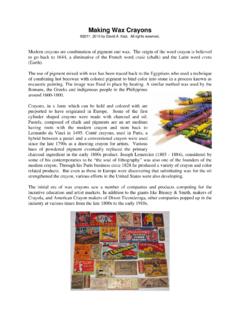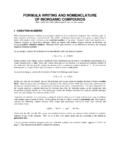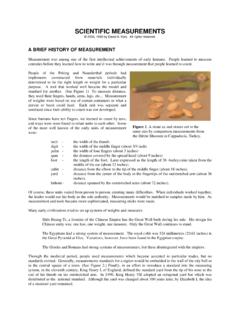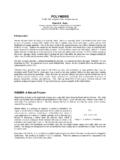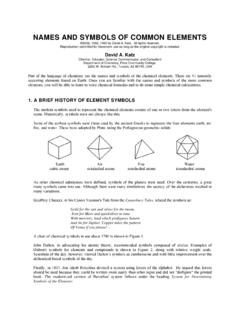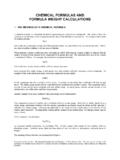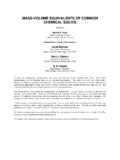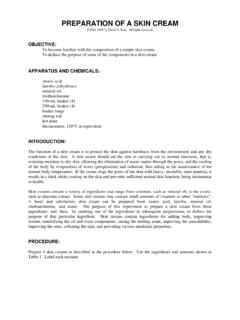Transcription of The Synthesis of Biodiesel from Vegetable Oil - chymist.com
1 1 The Synthesis of Biodiesel from Vegetable Oil 2012 by David A. Katz All rights reserved. Introduction The use of reclaimed Vegetable oil from restaurants, for use as a fuel for road vehicles, has received a lot of attention in recent years. Used Vegetable oils contain solids and free fatty acids due to oil breakdown during the frying process. Normally, the used oil must be filtered and the quantity of the free fatty acids must be determined so that the chemicals necessary for the breaking down of the cooking oil can be calculated. In this experiment the Biodiesel will be made from fresh Vegetable oil to avoid the solids and a titration to determine the mass of sodium hydroxide needed to react with the whole oil molecules.
2 The diesel engine was developed by Rudolf Diesel, a French thermal engineer, in 1893 with the first working prototype in 1897. A diesel engine works by creating heat by compressing air followed by the injection of fuel which burns, increasing pressure to drive the pistons. Early diesel engines were intended to run on peanut oil and were later adapted to run on the lower viscosity and cheaper petroleum diesel. Today, diesel engines are used in cars, buses and trucks. Biodiesel can be used directly in diesel engines or blended with petroleum based diesel fuel.
3 Vegetable oils are esters of glycerin, commonly called triglycerides, with different fatty acids with the structure: I2 IIIII2 OHC O C RO HC O C ROHC O C R . Where RI, RII, and RIII can be the same or different fatty acids. (See Table 1) The preparation of the Biodiesel is a transesterification reaction where the triglycerides are converted into simpler methyl esters of the fatty acids (the Biodiesel ). 22 NaOH32(catalyst)22 OHC O C RHC OHOO HC O C R + 3 CH OH3 H C O C RHC OHOHC O C RHC OH Triglyceride methanol fatty acid methyl ester glycerin 2 Table 1.
4 Fatty acid composition of some common edible fats and oils Percent by weight of total fatty acids Oil or Fat ratio Saturated fatty acids Mono unsaturated Polyunsaturated Capric Acid C10:0 LauricAcid C12:0 MyristicAcid C14:0 PalmiticAcid C16:0 StearicAcid C18:0 Oleic Acid C18:1 LinoleicAcid ( 6) C18:2 Alpha LinolenicAcid ( 3)C18:3 Canola Oil - - - 4 2 62 22 10 Coconut Oil 6 47 18 9 3 6 2 - Corn Oil (Maize Oil) - - - 11 2 28 58 1 Cottonseed Oil - - 1 22 3 19 54 1 Flaxseed Oil - - - 3 7 21 16 53 Grape seed Oil - - - 8 4 15 73 - Lard (Pork fat) - - 2 26 14 44 10 - Olive Oil - - - 13 3 71 10 1 Palm Oil - - 1 45 4 40 10 - Palm Kernel Oil 4 48 16 8 3 15 2 - Peanut Oil - - - 11 2 48 32 - Safflower Oil* - - - 7 2 13 78 - Sesame Oil - - - 9 4 41 45 - Soybean Oil - - - 11 4 24 54 7 Sunflower Oil* - - - 7 5 19 68 1 Notes.
5 Percentages may not add to 100% due to rounding and other constituents not listed. Where percentages vary, average values are used. The symbol C10:0 or C18:2 tells the number of carbon atoms in the fatty acid and the number of carbon carbon double bonds in the compound Safety Safety goggles must be worn at all times in the laboratory Sodium Hydroxide is caustic both as a solid and in solution. Significant heat is released when the sodium hydroxide dissolves in water. In the event of skin contact, wash the affected area with copious amounts of water.
6 Contact with the eyes can cause serious long-term damage. In the event of eye contact, go to the nearest eyewash and rinse the eyes for up to 15 minutes. Have all areas of contact evaluated by qualified medical personnel. Methanol is flammable. Work with the methanol away from any ignition source. (NOTE: Hotplates can spark, unseen to the experimenter.) The flame above burning methanol is virtually invisible, so it is not always easy to observe a methanol flame. Methanol vapors are toxic, work in a well ventilated area. When burning the Biodiesel , work in a fume hood.
7 3 Disposal All wastes from the reaction should be placed in a bottle labeled for Vegetable oil, glycerin and methanol. A separate container will be provided for collection of the Biodiesel . Materials Needed Vegetable oil (soybean, peanut, cottonseed, coconut, or other oil of your choice) Sodium hydroxide, NaOH, pellets Methanol, CH3OH, absolute Sodium chloride, NaCl Sodium sulfate, Na2SO4, anhydrous Steel wool 125 mL Erlenmeyer flask 2 - 100 mL or 150 mL beakers 50 mL graduated cylinder Thermometer, 110 or 120 C Separatory funnel Watch glass Mortar and pestle Vacuum filtration apparatus.
8 Side arm flask with B chner funnel and filter paper Magnetic stir bar Stirring hot plate pH paper test tube, 12 x 75 mm test tube rack digital thermometer or Lab Pro with temperature probe Procedure Measure out 14 mL of methanol and put into the 125 mL Erlenmeyer flask. Weigh out of sodium hydroxide pellets. Crush these pellets in a clean, dry mortar and pestle. Transfer the crushed solid into the flask containing the methanol. Place a stir bar into the flask, place it on a magnetic stirrer and stir for 5-10 minutes until the NaOH dissolves. Measure out 60 mL of Vegetable oil, determine the mass of the oil and add this to the reaction flask.
9 Heat the flask and its contents to a temperature between 45 and 50 C for 20 to 30 minutes with continuous stirring such that the mixture does not separate into two layers. While still warm, pour the mixture into a separatory funnel and allow to cool until the mixture separates into two layers. The upper layer will be the Biodiesel and the lower layer will be mostly glycerin. Do not let it stand for too long as the lower layer may solidify. 4 Drain the lower layer into a 100 mL beaker. This solution contains glycerin, unreacted methanol, unreacted sodium hydroxide, a trace of water and salts.
10 In a commercial process, the glycerin and methanol can be collected for reuse. In this experiment, it will be disposed in a waste container labeled for glycerin and methanol. The top layer in the separatory funnel should be the Biodiesel . It will be contaminated with traces of methanol, glycerin, unreacted sodium hydroxide, and some soap which is a byproduct of the reaction. (Soap is the sodium salt of a fatty acid.) Wash the Biodiesel by adding 10 mL of tap water to the separatory funnel. Gently swirl the mixture for about 1 minute to dissolve the methanol, glycerin, sodium hydroxide, and any soap.

